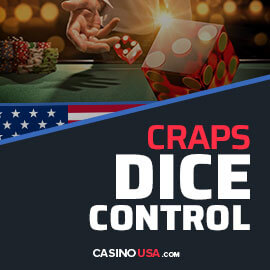- Slots
- Blackjack
- Roulette
- Live Dealer
- Baccarat
- Great selection of slots
- High-quality live dealer games
- Excellent welcome bonus
- Crypto-friendly
- Slots
- Blackjack
- Roulette
- Live Dealer
- Baccarat
- 300+ games
- Crypto-friendly casino
- Live dealer jackpot
- Bonus galore for different verticals
- Slots
- Blackjack
- Roulette
- Live Dealer
- Baccarat
- Reputable online casino with 26+ years’ experience
- Wide range of deposit bonuses for sports bettors and casino players
- Outstanding customer support
- Several different cryptocurrencies accepted for deposits and withdrawals

One of the most prominent theories in craps is dice control. This article will dissect the theory and explain what it entails. In the end, you’ll be able to decide whether it would work.
Let’s begin.
Dice Control Explained
Many believe that dice control is a myth. The idea that a single player can control the dice on a table lined with pyramidal rubber and speed bumps is highly improbable. However, not everyone would agree. If you dig a little deeper, you’ll find numerous books, shows, and seminars explaining and teaching dice control.
Some compare dice throwing to golf. Just like a golf player can direct the ball into a hole, a craps shooter can perfect a throwing technique and influence the roll outcome. By proposing this theory, people question the nature of the game.
Is craps truly luck-based? Or is there some skill to it?
According to the community of “dice shooters,” two factors heavily impact the dice control theory — dice setting and throwing technique.
Let’s examine each one.
Dice Setting
Dice setting refers to the way the dice are positioned before the shooter throws them. Two craps dice create hundreds of different combinations. However, according to the experts, you only need to use a few:
Hardways
![]() This is the most popular dice set that offers the ultimate protection against rolling a 7.
This is the most popular dice set that offers the ultimate protection against rolling a 7.
Keeping your dice on an axis reduces the presence of 7s and focuses on box numbers.
All 7s
![]() Shooters often use this set on the Come Out roll.
Shooters often use this set on the Come Out roll.
It shows a 7 on all sides, so if rolled correctly, it offers the best odds of hitting a natural 7 or 11.
Flying “V”
![]() The two 3s pressed together at the top form a “V.”
The two 3s pressed together at the top form a “V.”
This set is great for rolling inside numbers (5, 6, 8, 9).
Mini “V”
![]() Press 2s together, and you get a mini “V.”
Press 2s together, and you get a mini “V.”
Shooters use this combination when aiming at outside numbers (4, 5, 9, 10).
Straight 6s
![]() Here, the 6s run across the top of the dice, with 2s and 5s in the front/back.
Here, the 6s run across the top of the dice, with 2s and 5s in the front/back.
This is a good set for a Come Out roll with a Pass Line bet.
Throwing Technique
Besides setting the dice right, knowing how to throw them is critical in dice control. When gripping the dice, shooters must ensure not to disturb the setting; otherwise, everything falls apart.
On top of that, the angle at which the shooters roll the dice and the motion is critical. Most shooters use a swinging arm motion while maintaining a ~45-degree angle. This throw will ensure the dice go far on the table, drop on the felt first, and gently hit the side of the table in an attempt to reduce randomness.
The throwing technique takes a lot of practice. Even experienced players have failed to master it, so don’t be disappointed if you don’t succeed on the first few tries.
Conclusion
People will always try to beat the casino at its game, but we’re still skeptical regarding dice control. Although it may work in some instances, learning how to throw the dice will never guarantee a win.
So, is it worth it? Probably not. Should you try it? It’s up to you. But remember, casinos always win in the long run, so don’t get carried away trying to beat the house.



